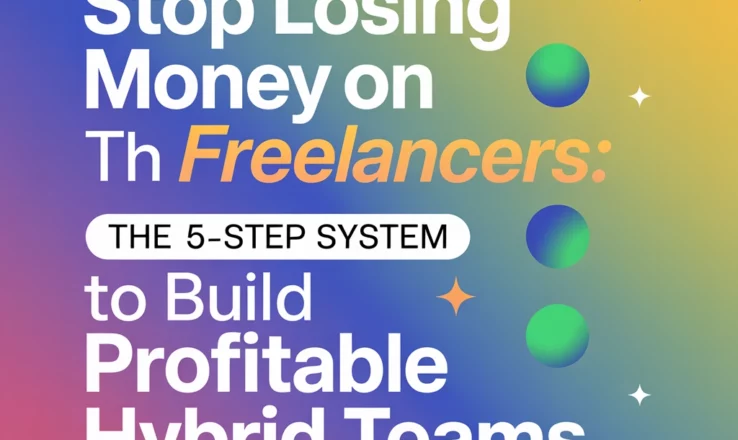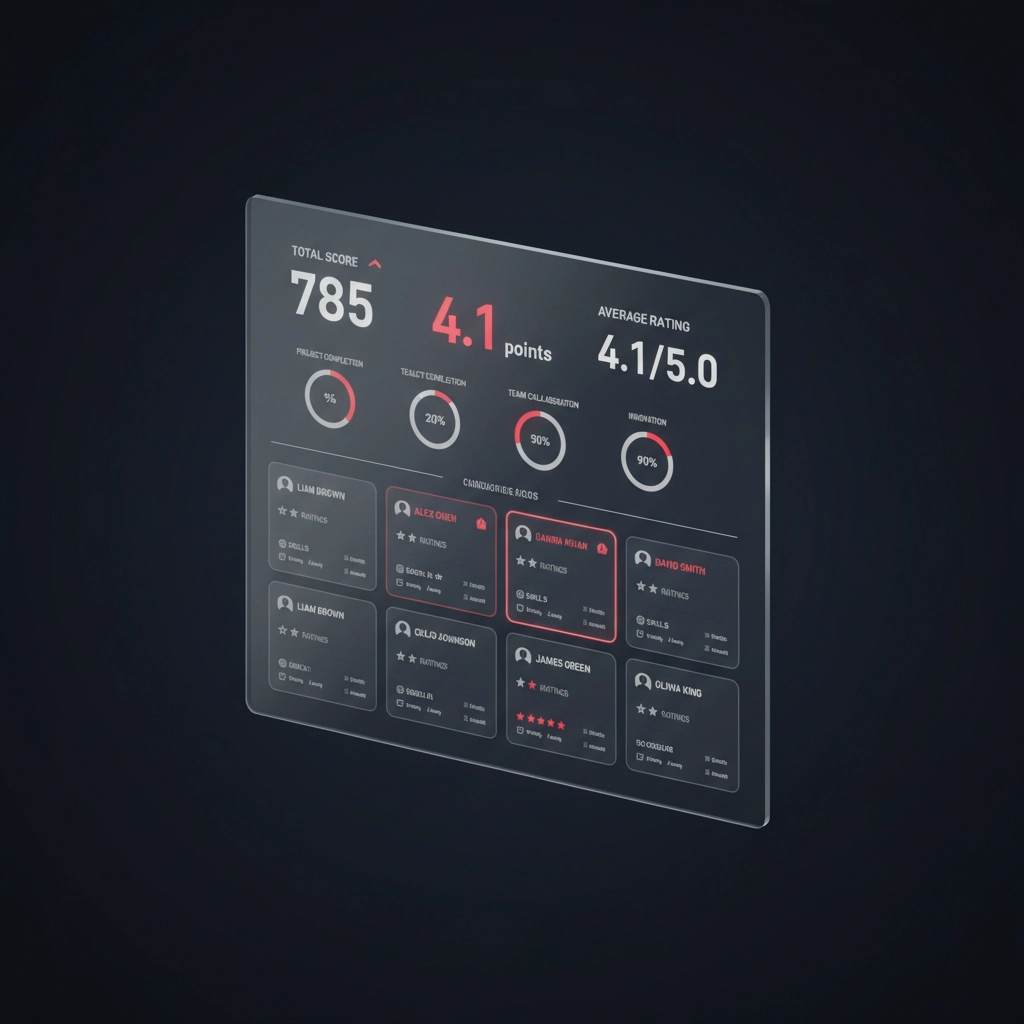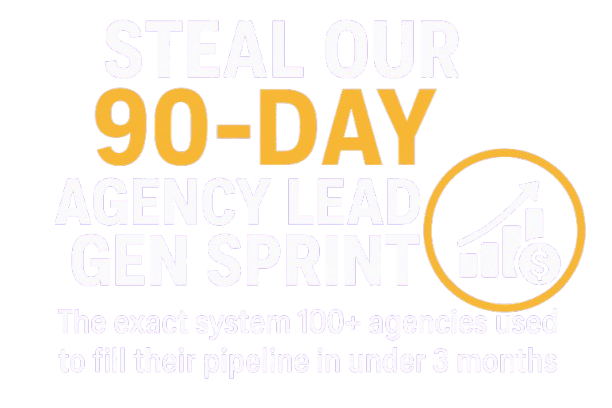
Here's the brutal truth: most agency founders are hemorrhaging money on freelancers without even realizing it. You're paying premium rates, dealing with constant turnover, and watching projects drag on while your profit margins evaporate.
But here's what the data tells us: it takes five times more resources and effort to find a new freelancer for every project compared to establishing strong ongoing working relationships. That's not just wasteful spending; it's strategic suicide in today's competitive landscape.
Today, we're going to fix this. I'm going to walk you through the exact 5-step system I've developed over 15 years of building and scaling agencies. This isn't fluffy advice: it's a battle-tested methodology that transforms freelancer relationships from cost centers into profit drivers.
All I ask is that you take this seriously. Be ready to get your hands dirty and implement what you learn here. The agencies that master this system consistently report 65% reduction in freelancer turnover and 40% faster project completion times. That's the difference between struggling and scaling.
Step 1: Strategic Selection & Vetting (Stop Hiring on Impulse)
Most agency founders hire freelancers like they're ordering takeout: quick, convenient, and often regrettable. This reactive approach is killing your profitability before projects even start.
Here's what you're going to do instead:
Create Your Freelancer Scorecard
Build a standardized evaluation system that goes beyond portfolios and hourly rates. Rate candidates on these critical factors:
- Communication responsiveness (test this during initial outreach)
- Project complexity experience (not just years in business)
- Technology stack alignment with your systems
- Long-term availability and capacity planning
- Cultural fit indicators (this matters more than you think)
Conduct Strategic Interviews
Stop treating freelancer interviews like casual chats. Here's your new process:
Ask specific scenario-based questions: "Walk me through how you'd handle a client requesting major scope changes three days before launch." Their answer reveals problem-solving skills and boundary-setting capabilities.
Request work samples that mirror your actual projects. Generic portfolio pieces tell you nothing about their ability to deliver for your specific client needs.
The 48-Hour Test Project
Before committing to larger engagements, assign a small, paid test project. This isn't about getting free work: it's about evaluating working relationships under real conditions. Pay fairly, but make the stakes clear: exceptional performance leads to ongoing partnership.

Step 2: Integration & Communication Systems (Make Them Part of Your Team, Not Outside Contractors)
This is where most agencies fail spectacularly. You bring freelancers into projects without proper integration, then wonder why collaboration feels disjointed and results suffer.
Implement Your Onboarding Protocol
Within 24 hours of project kickoff, conduct a dedicated integration call. Here's your agenda:
- Share comprehensive brand guidelines and style standards
- Introduce them to key team members across departments
- Establish clear communication protocols and response time expectations
- Review project management tools and file organization systems
- Discuss your internal language, acronyms, and cultural nuances
This isn't optional. Freelancers who understand your business context from day one become productive 60% faster than those left to figure things out independently.
Create Communication Rhythms
Establish predictable touchpoints that prevent projects from going dark:
- Daily check-ins during active project phases (5-minute calls or structured Slack updates)
- Weekly strategy alignments for longer engagements
- Monthly relationship maintenance conversations (separate from project discussions)
Foster Cross-Team Collaboration
Don't silo freelancers into individual contributors. Create opportunities for them to collaborate with your full-time team:
- Include them in relevant brainstorming sessions
- Invite participation in team problem-solving discussions
- Share credit publicly when their contributions drive project success
Remember: freelancers who feel like team members perform like team members.
Step 3: Performance Management & Accountability (Set Standards, Measure Results)
Here's where the rubber meets the road. Without clear performance standards and accountability systems, even talented freelancers drift toward mediocrity.
Define Success Metrics Upfront
Before any work begins, establish specific, measurable success criteria:
- Quality benchmarks with concrete examples
- Timeline expectations with milestone checkpoints
- Communication standards and responsiveness requirements
- Revision protocols and approval processes
Document everything. Verbal agreements lead to expensive misunderstandings.
Implement Progress Tracking Systems
Use project management tools that provide visibility into work progress:
- Time tracking for hourly engagements (but focus on value delivery, not micromanagement)
- Milestone completion with deliverable reviews
- Quality checkpoints at predetermined intervals
- Client satisfaction feedback integration
Address Issues Immediately
When performance gaps emerge, address them within 24 hours. Here's your framework:
- Identify the specific gap: "The deliverable missed our established quality standard in these three areas…"
- Understand the root cause: Ask questions before assuming intent or capability issues
- Provide concrete improvement guidance: Share examples of expected quality level
- Set clear timeline for improvement: "I need to see these improvements in the next deliverable due Friday"
- Follow up consistently: Don't assume feedback was implemented without verification

Step 4: Technology Stack Optimization (Stop the Tool Chaos)
Technology chaos kills freelancer productivity and drives up your costs. Most agencies use scattered tools that create friction instead of facilitating collaboration.
Audit Your Current Stack
Take inventory of every tool your team uses for:
- Project management and task tracking
- File sharing and version control
- Communication (internal and client-facing)
- Time tracking and invoicing
- Creative collaboration and feedback
If you're using more than 6-8 core tools, you're creating unnecessary complexity.
Consolidate for Efficiency
Choose integrated platforms that handle multiple functions:
- Project management tools with built-in time tracking and communication features
- File sharing systems with version control and commenting capabilities
- All-in-one client portals for project updates and approval workflows
Train freelancers thoroughly on your chosen tools. Invest time upfront to eliminate ongoing friction.
Create System Documentation
Build comprehensive guides that freelancers can reference:
- Tool access and permission settings
- File naming conventions and folder structures
- Workflow processes and handoff protocols
- Troubleshooting common technical issues
Update documentation regularly and make it easily accessible. Freelancers shouldn't waste billable time figuring out your systems.
Step 5: Relationship Nurturing & Retention (Transform Contractors into Strategic Partners)
This final step separates profitable agencies from struggling ones. While competitors treat freelancers as disposable resources, you're going to build a network of committed partners who prioritize your projects.
Implement Recognition Systems
Acknowledge exceptional work publicly and consistently:
- Share freelancer successes with your entire team
- Highlight their contributions in client presentations
- Provide LinkedIn recommendations for outstanding performance
- Consider performance bonuses for projects that exceed expectations
Recognition costs nothing but builds invaluable loyalty.
Offer Professional Development Opportunities
When you invest in freelancer growth, they become more valuable to your projects:
- Include them in relevant training sessions and workshops
- Share industry insights and trend analysis
- Provide feedback that helps them improve their craft
- Connect them with growth opportunities within your network
Plan for Long-Term Partnerships
The most profitable freelancer relationships span years, not projects:
- Discuss capacity planning and future project pipeline
- Negotiate preferred rates for ongoing partnerships
- Create retainer arrangements for consistent availability
- Involve top performers in strategic planning discussions
Maintain Relationships Between Projects
Don't go radio silent between engagements:
- Send quarterly check-ins to maintain connection
- Share relevant opportunities in your network
- Invite them to team events and celebrations
- Provide references and recommendations when requested
The freelancers who feel valued and supported will prioritize your projects when capacity gets tight.

The Implementation Reality Check
Here's what implementing this system looks like in practice:
Week 1-2: Audit your current freelancer relationships and document gaps in your existing processes. Create scorecards and communication protocols.
Week 3-4: Begin implementing new onboarding and integration processes with incoming freelancers. Start relationship maintenance conversations with existing partners.
Month 2: Refine technology stack and create system documentation. Begin measuring performance against new success metrics.
Month 3+: Focus on relationship nurturing and long-term partnership development. Track improvements in project completion times and freelancer retention.
The agencies that commit to this systematic approach consistently see dramatic improvements in both project profitability and team performance. But implementation requires discipline: you can't cherry-pick steps and expect transformational results.
Your freelancer relationships are either strategic assets or expensive liabilities. There's no middle ground. This system transforms them into your competitive advantage, but only if you commit to doing the work consistently.
Now stop losing money on disconnected freelancer relationships and start building the hybrid team that scales your agency profitably. Your future self will thank you for making this investment in systematic excellence.
